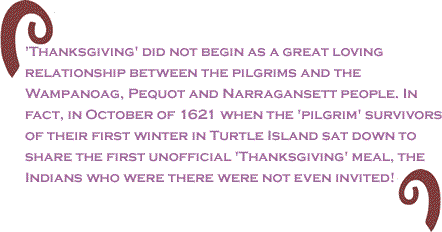Let
me begin by stating that thousands of years before the 'official'
Thanksgiving Day was proclaimed by Governor Winthrop of
the Massachusetts Bay Colony in 1637, North American Indigenous
people across the continent had celebrated seasons of Thanksgiving.
'Thanksgiving' is a very ancient concept to American Indian
nations. The big problem with the American Thanksgiving
holiday is its false association with American Indian people.
The infamous 'Indians and pilgrims' myth. It is good to
celebrate Thanksgiving, to be thankful for your blessings.
It is not good to distort history, to falsely portray the
origin of this holiday and lie about the truth of its actual
inception. Here are some accurate historical facts about
the true origin of this American holiday that may interest
you.

'Thanksgiving'
did not begin as a great loving relationship between the
pilgrims and the Wampanoag, Pequot and Narragansett people.
In fact, in October of 1621 when the 'pilgrim' survivors
of their first winter in Turtle Island sat down to share
the first unofficial 'Thanksgiving' meal, the Indians who
were there were not even invited! There was no turkey, squash,
cranberry sauce or pumpkin pie. A few days before this alleged
feast took place, a company of 'pilgrims' led by Miles Standish
actively sought the head of a local Indian leader, and an
11 foot high wall was erected around the entire Plymouth
settlement for the very purpose of keeping Indians out!
Officially, the holiday we know as 'Thanksgiving' actually
came into existence in the year 1637. Governor Winthrop
of the Massachusetts Bay Colony proclaimed this first official
day of Thanksgiving and feasting to celebrate the return
of the colony's men who had arrived safely from what is
now Mystic, Connecticut. They had gone there to participate
in the massacre of over 700 Pequot men, women and children,
and Mr. Winthrop decided to dedicate an official day of
thanksgiving complete with a feast to 'give thanks' for
their great 'victory'.

As
hard as it may be to conceive, this is the actual origin
of our current Thanksgiving Day holiday. Many American Indian
people these days do not observe this holiday, for obvious
reasons. I see nothing wrong with gathering with family
to give thanks to our Creator for our blessings and sharing
a meal. I do, however, hope that Americans as a whole will
one day acknowledge the true origin of this holiday, and
remember the pain, loss, and agony of the Indigenous people
who suffered at the hands of the so-called 'pilgrims'. It
is my hope that children's plays about 'the first Thanksgiving',
complete with Indians and pilgrims chumming at the dinner
table, will someday be a thing of the past. Why perpetuate
a lie? Let us face the truths of the past, and give thanks
that we are learning to love one another for the rich human
diversity we share.

BlackCommentator.com
Guest Commentator John Two-Hawks is a Musician, Flute Virtuoso,
Author & Orator. He is the Founder of Native Circle and the
Circle
of Nations Global Community. Click here
to contact Mr. Two-Hawks. |

